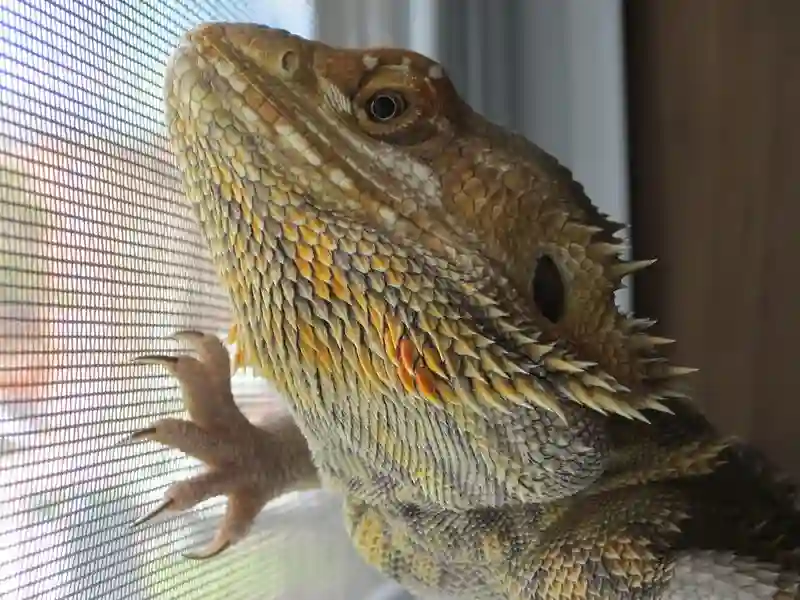Yellow Fungus is a common fungal infection affecting Bearded Dragons (Pogona vitticeps) and other reptiles. Also known as Chrysosporium anamorph of Nannizziopsis vriesii (CANV) or Yellow Skin Disease.
Symptoms include discolored scales, irregular shedding, and crusty yellow or dark lesions on the skin. A Betadine bath or topical antifungal cream may help manage the infection and keep the dragon clean.
Symptoms of Yellow Fungus in Bearded Dragons
Yellow Fungus infection can manifest in various ways, and symptoms may not be immediately apparent. Some common signs include:
- Discolored patches: Yellow, brown, or gray scaly patches on the skin, which may become crusty over time.
- Skin shedding issues: Difficulty shedding skin or retaining shed skin, leading to a rough appearance.
- Lethargy: Reduced activity levels, lack of appetite, and overall weakness.
- Weight loss: Rapid or unexplained weight loss, despite adequate food intake.
- Skin lesions: Open sores or wounds that do not heal properly, often accompanied by a foul smell.
- Secondary infections: Bacterial or fungal infections that may occur as a result of compromised skin integrity.
Causes of Yellow Fungus in Bearded Dragons
Several factors can contribute to the development of Yellow Fungus in Bearded Dragons:
- Poor hygiene: An unclean habitat with excess waste, damp substrate, or high humidity can promote fungal growth.
- Weak immune system: Dragons with compromised immune systems due to stress, illness, or improper husbandry are more susceptible to infections.
- Direct contact: Transmission can occur through contact with infected animals, contaminated objects, or even the environment.
Diagnosing Yellow Fungus
To accurately diagnose Yellow Fungus, it is essential to consult an experienced reptile veterinarian. The vet may perform the following diagnostic tests:
- Visual inspection: A thorough examination of the affected areas to assess the severity of the infection.
- Skin scraping: The collection of skin samples for microscopic examination or fungal culture to confirm the presence of CANV.
Treatment Options for Yellow Fungus
Early detection and prompt treatment are crucial for a successful recovery. Treatment options include:
- Topical antifungal medications: Prescription creams or ointments are applied directly to the affected areas.
- Oral antifungal medications: Systemic drugs, such as itraconazole or voriconazole, are administered under a vet’s supervision.
- Surgical debridement: Removal of severely affected tissue to prevent the spread of the infection.
- Supportive care: Maintaining proper hydration, nutrition, and environmental conditions to support the immune system and overall health of the Bearded Dragon.
Prevention Measures for Yellow Fungus
Prevention is key to protecting your Bearded Dragon from Yellow fungi. Implement the following measures to minimize the risk of infection:
- Maintain a clean environment: Regularly clean and disinfect the enclosure, substrate, and accessories to prevent fungal growth.
- Proper humidity levels: Ensure that the habitat has the appropriate humidity levels, as high humidity can encourage fungal growth.
- Quarantine new animals: Keep new Bearded Dragons separate from your existing reptiles for at least 30 days to monitor for any signs of illness.
- Minimize stress: Reduce stress by providing adequate space, hiding spots, and proper temperature gradients in the enclosure.
- Regular health check-ups: Schedule regular veterinary appointments to monitor your Bearded Dragon’s health and detect any issues early.
Is Yellow Fungus contagious to humans or other pets?
Yellow Fungus is primarily a concern for reptiles, particularly Bearded Dragons. While it is uncommon for humans to contract Yellow Fungus, immunocompromised individuals may be at a higher risk.
It is essential to practice good hygiene when handling your Bearded Dragon and always wash your hands thoroughly afterward. If you have other reptiles, it is important to isolate an infected Bearded Dragon to prevent the spread of the infection.
How long does it take to treat Yellow Fungus?
The duration of treatment for Yellow Fungus depends on the severity of the infection and the individual Bearded Dragon’s response to treatment.
Treatment may take several weeks to months and requires consistent administration of prescribed antifungal medications, proper husbandry, and monitoring. It is important to follow your veterinarian’s recommendations and continue treatment as advised, even if symptoms appear to improve.
Can Yellow Fungus in Bearded Dragons be completely cured?
In many cases, early detection and prompt treatment can lead to a successful recovery from Yellow Fungus. However, some Bearded Dragons may experience recurring infections or suffer from chronic symptoms.
Conclusion
Yellow Fungus in Bearded Dragons is a serious health concern that can lead to severe complications and even death if not treated promptly. Prevention measures, such as maintaining a clean environment and proper husbandry practices, are crucial in safeguarding your reptile’s health. Always consult with an experienced reptile veterinarian for accurate diagnosis and treatment recommendations.

